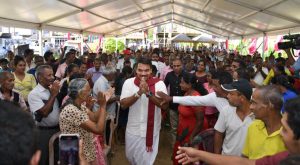Sri Lanka Podujana Peramuna (SLPP), the party of the Rajapaksas, has nominated Namal Rajapaksa as its candidate for the September 21 presidential election. Namal is the son of former President Mahinda Rajapaksa.
The SLPP nominated Namal on August 7 after businessman Dhammika Perera, who was expected to be the party’s presidential candidate, informed the SLPP General Secretary that he didn’t want to run due to personal reasons.
Few in Sri Lanka believe that Perera withdrew entirely of his own accord.
It is unlikely that Perera would have expressed his desire to contest in the first place had he not received a green light from the Rajapaksas, who control the SLPP with an iron fist. The SLPP is a political party by the Rajapaksas for the Rajapaksas.
There are four main candidates in the fray for the upcoming presidential election. They are Anura Kumara Dissanayake representing the National People’s Power (NPP), President Ranil Wickremesinghe contesting as an independent candidate, opposition leader Sajith Premadasa of the Samagi Jana Sandanaya (SJS), and Namal of the SLPP. Opinion polls indicate that Dissanayake and Premadasa are the frontrunners, followed by Wickremesinghe and then Rajapaksa as a distant fourth.
Most Sri Lankans believe that the Rajapaksas are the cause of their current economic ills, and hence Namal’s electoral prospects are weak. He has taken a substantial gamble with his political future by throwing his hat in the ring.
Namal, who is 38, probably has a long career ahead of him as a politician. Being the face of a disastrous presidential election would deal a severe blow to his credentials.
Consequently, many Sri Lankans believed the SLPP would field Perera for the presidential election, let him be the fall guy, and slowly rebuild under the leadership of Namal.
So, why did the Rajapaksas change their mind at the eleventh hour? Why are they risking the political career of Namal Rajapaksa?
Probably the decision to field Namal was taken after over 90 SLPP parliamentarians abandoned ship and joined Wickremesinghe. These MPs were SLPP district leaders, and they took along with them most of the remaining grassroots-level activists. At best, the party now has a few MPs and grassroots organizers, and these numbers will further dwindle as more people cross over to Wickremesinghe or Premadasa.
The NPP has insisted it will not entertain horse-trading. Thus, the SLPP no longer has an established network on the ground to carry out an effective political campaign. There are only five weeks before the presidential election.
Perera has little political experience. He is not a charismatic leader. He doesn’t have name recognition and he has plenty of skeletons in his closet. The remaining Rajapaksa voters, having no loyalty or bond to him, might explore other possibilities. Without an established political network on the ground to do the heavy lifting, Perera would have been decimated at the September presidential election.
Although 38, Namal Rajapaksa has been a parliamentarian since 2010, making this his third stint in Parliament. This makes him one of the most experienced politicians left in the SLPP. A third-generation politician, he knows the intricacies of Sri Lankan politics. He has name recognition and is probably the only man, apart from his ailing father, who can gather the votes of Rajapaksa loyalists.
Whoever wins the presidential election would dissolve Parliament immediately and, to capitalize on the political momentum, will call a snap parliamentary election. Therefore, the parties also need to think about securing as many seats as possible in the coming parliamentary election, which in turn depends on their performance in the presidential election.
In the 2020 general election, the SLPP secured 145 seats in the 225-member Parliament. However, within four years, it faces the threat of a whitewash akin to the disastrous showing by its parent party, the Sri Lanka Freedom Party (SLFP) in 1977. A young Mahinda Rajapaksa witnessed the decimation of the party and a subsequent 17-year stint in the opposition.
As SLPP leader, he would want to avoid the fate that befell the SLFP and ensure his party maintains a foothold in Parliament. In a highly competitive, fragmented Parliament, 10-12 seats can give the SLPP significant power as a tiebreaker.
After considering everything at stake and all the options available, the Rajapaksa family has decided to stake Namal’s reputation for a final throw of political dice.
We will know in the next few weeks whether this gambit works, or whether Namal along with the SLPP will be relegated to the political wilderness for the foreseeable future.

































